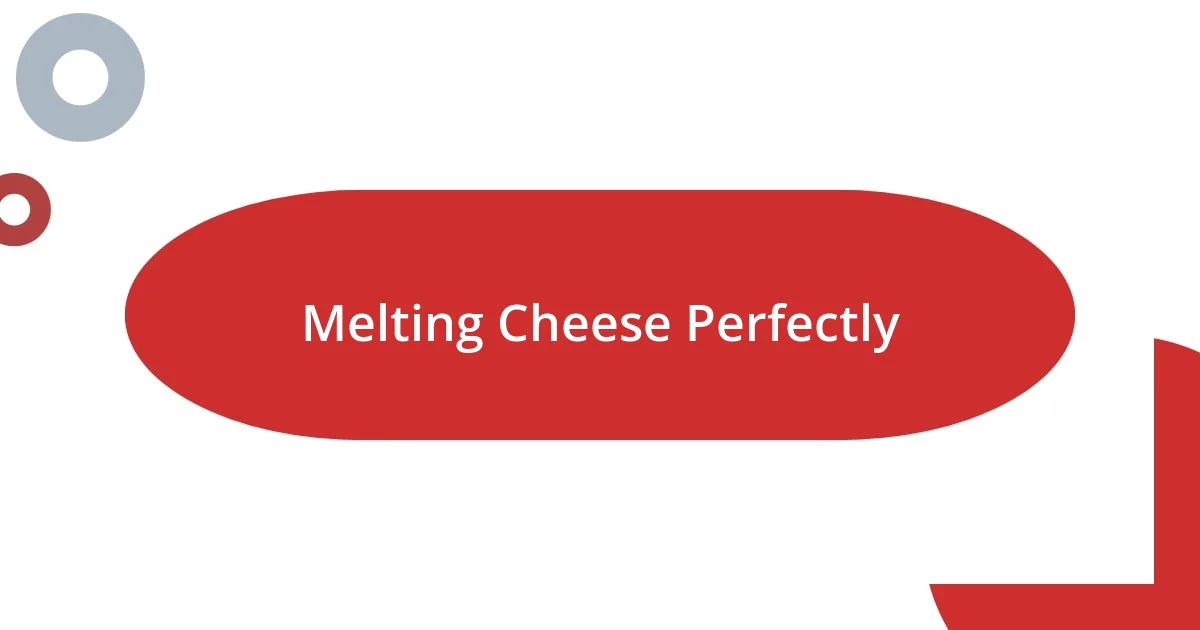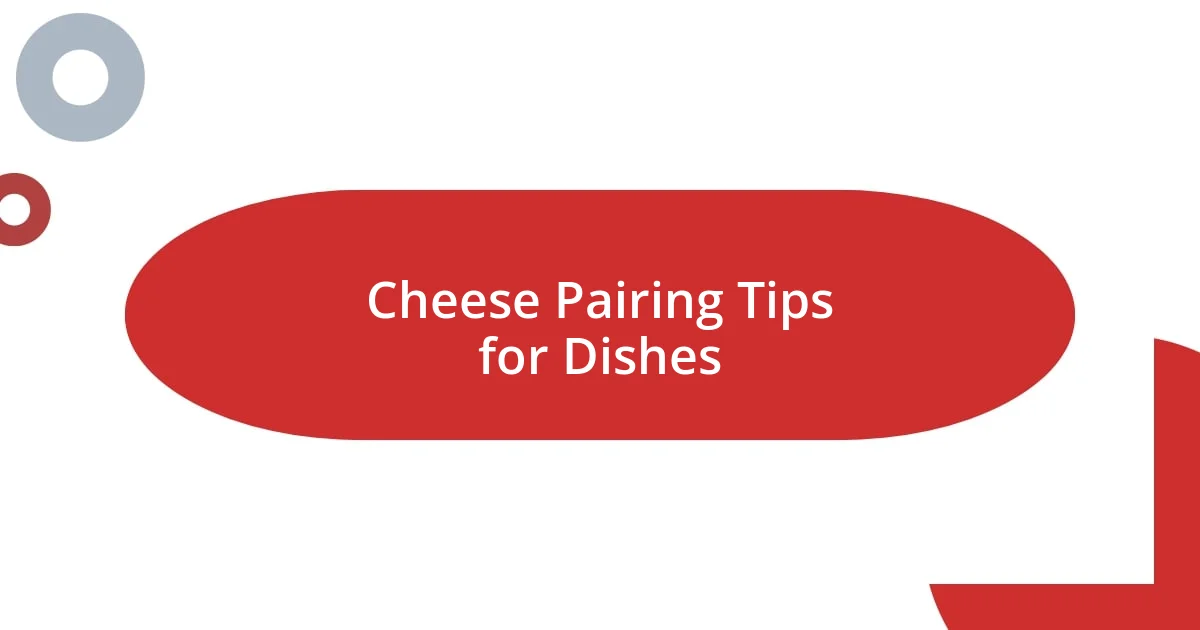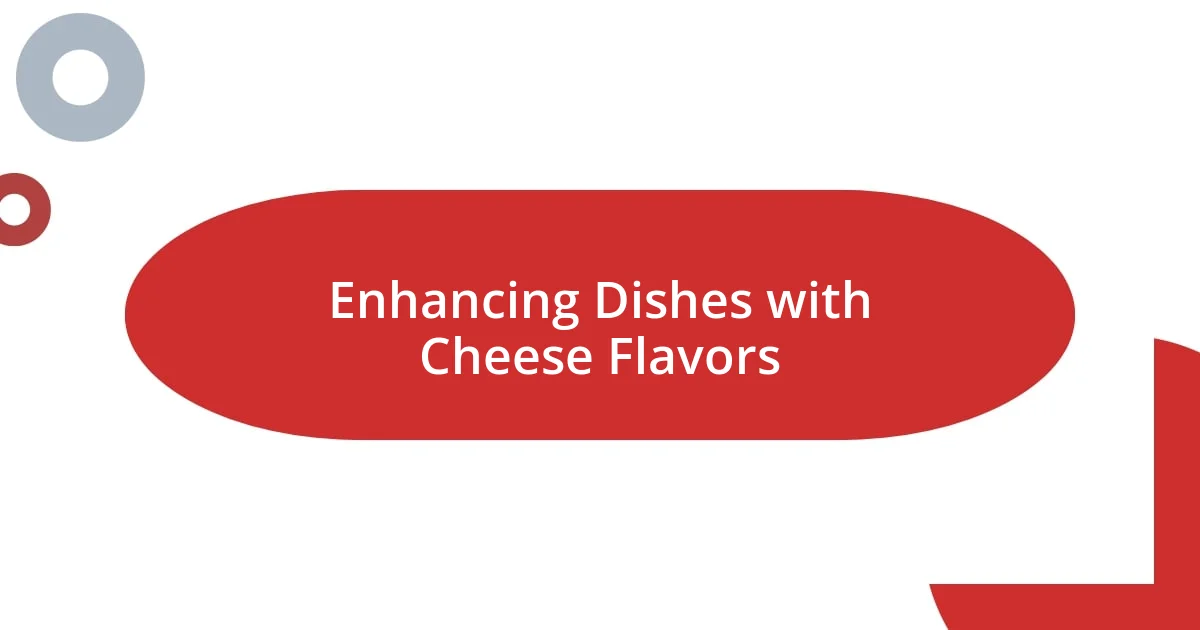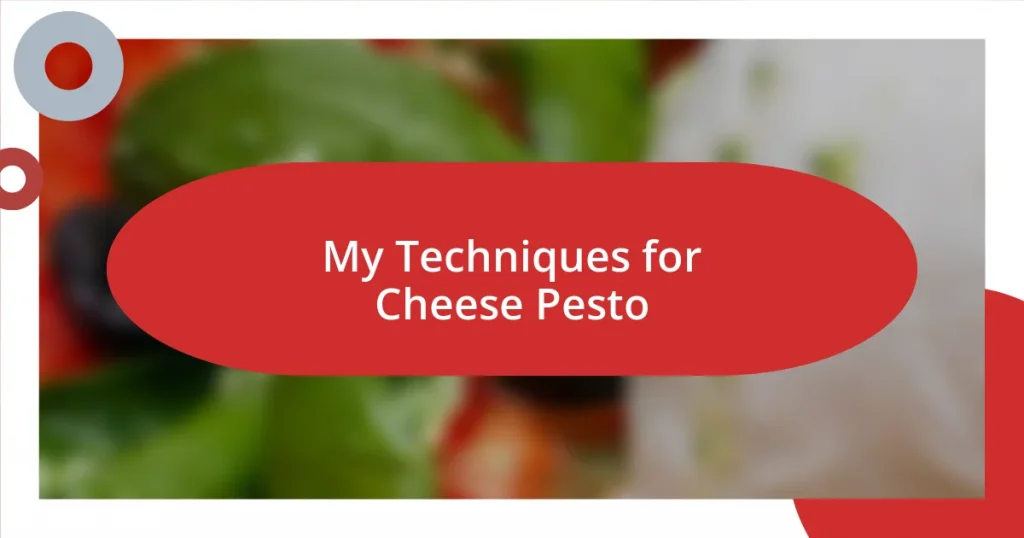Key takeaways:
- Choosing the right cheese enhances flavors and textures in dishes, creating unforgettable culinary experiences.
- Preparation methods and the temperature of cheese can significantly impact its melting quality and overall dish success.
- Incorporating cheese into sauces and experimenting with pairings elevate meals, transforming simple dishes into gourmet delights.

Choosing the Right Cheese
Choosing the right cheese can truly elevate a dish, and honestly, it’s one of my favorite parts of cooking. Think back to that moment when you took a bite of a perfectly cheesy lasagna—what was it that made it unforgettable? Was it the rich, creamy texture of mozzarella or the sharp, tangy punch of Parmesan? Each cheese brings its own personality, and it’s crucial to consider what flavor you’re aiming to enhance.
When I’m experimenting in the kitchen, I often look for cheeses that contrast or complement the other ingredients. For instance, combining a salty feta with sweet roasted vegetables creates a delightful balance that makes my taste buds dance with joy. The joy of cheese lies in its versatility, so I ponder: how will the cheese interact with other flavors? This question leads me to discover surprising pairings, like a sharp cheddar with apple slices, which always leaves my guests asking for more.
I remember one dinner party where I had a selection of cheeses laid out, and one friend boldly tried a smoky Gouda with spicy chorizo. The explosion of flavors left everyone in awe, proving how essential the right cheese can be. It’s experiences like these that remind me how crucial it is to choose thoughtfully—not just in terms of flavor, but also in texture and aroma. So, what will you choose for your next dish? The option can truly transform the overall experience!

Preparing Cheese for Cooking
When preparing cheese for cooking, I often find it crucial to consider the cheese’s texture and moisture content. For example, a soft cheese like ricotta blends beautifully into sauces, adding creaminess and depth. On the flip side, firmer cheeses like Parmesan grate easily and can provide a fantastic finishing touch on a dish. Have you ever discovered the joy of grating fresh Parmesan over a steaming bowl of pasta? It’s a simple step that elevates the whole experience.
I like to take the time to let my cheeses come to room temperature before cooking. This small detail makes a world of difference. Did you know that it enhances the flavors and allows for better melting? When I made a three-cheese mac and cheese, bringing my cheddar, Gruyère, and fontina to room temperature made it ooze perfectly, creating a luscious, cheesy blanket that had everyone coming back for seconds. It’s all about those little moments of preparation that enhance the final dish!
Another aspect I find essential is cutting or shredding cheese into uniform pieces. This consistency ensures even melting and optimal flavor distribution. I vividly recall when I failed to shred my mozzarella evenly once; it clumped together and didn’t melt as beautifully as I had imagined for my pizza night. The result? A cheesy disaster that tasted good but didn’t have that dreamy, stretchy quality I was aiming for. I learned my lesson that day—preparation truly matters!
| Cheese Type | Preparation Method |
|---|---|
| Soft | Blend or Whip |
| Firm | Grate or Shred |
| Hard | Chop or Slice |
| Creamy | Let Sit |

Melting Cheese Perfectly
Melting Cheese Perfectly
Mastering the art of melting cheese is essential for creating that gooey, indulgent texture we all crave. I still remember the first time I tried to make a cheese dip, using a mix of cheddar and American cheese. The key was low heat, which allowed the cheese to melt slowly without seizing. If you rush it, you end up with a grainy mess that no one wants to dip into, and trust me, that’s a disappointment I won’t forget!
To ensure your cheese melts just right, here are some crucial tips:
– Choose the Right Heat: Always use low to medium heat to prevent scorching.
– Add Liquid: Incorporating a splash of milk or cream helps create a smoother melt.
– Grate or Shred: Smaller pieces melt faster and more uniformly.
– Experiment with Combinations: Mix different cheeses for complexity—think sharp cheddar with creamy mozzarella.
– Keep It Moving: Stirring regularly promotes even melting and prevents clumping.
Just the other night, I decided to host an impromptu fondue night, and I was thrilled with how effortlessly my cheese blend came together. With a little white wine and fresh garlic added, the cheese melted perfectly into a silky dip that had everyone enjoying their bread sticks a little too eagerly. Food moments like these remind me of the simple joys in cooking—it’s not just about the cheese; it’s about crafting experiences that linger long after the meal is over.

Incorporating Cheese into Sauces
Incorporating cheese into sauces can really elevate a dish from ordinary to extraordinary. I love adding a generous handful of shredded cheese to my homemade marinara sauce right at the end of cooking. As it melts, it creates a rich and velvety texture that clings beautifully to pasta. Can you imagine the aroma that fills the kitchen? It’s a delightful experience that makes you eager for that first bite.
One of my favorite combinations is using a creamy goat cheese in a white sauce. I once decided to adapt a traditional alfredo recipe by stirring in goat cheese along with the usual ingredients. The result was nothing short of magical. It added a tangy depth that balanced the richness of the cream and butter perfectly. It’s moments like these that remind me how a simple ingredient can surprise you and make your taste buds dance.
Recently, I experimented with a spicy cheese sauce to drizzle over roasted vegetables. I blended cream cheese with some jalapeños and a splash of lime juice. As it simmered, the sauce transformed into a vibrant, zesty treat that completely changed the flavor profile of the dish. Who would have thought that cheese could unlock such fresh flavors? Approaching sauces this way not only enhances the dish but brings an enjoyable adventure into the kitchen.

Cheese Pairing Tips for Dishes
Cheese pairings can truly transform the flavor profile of your dishes. I remember a summer barbecue where I decided to elevate my burgers by experimenting with different cheeses. Imagine a juicy patty topped not just with any cheese, but a slice of sharp blue cheese. The depth of flavor complemented the smoky grill marks beautifully. Ever tried that? The creaminess of the blue cheese balanced the richness of the meat in such an unexpected way that it captivated everyone at the table.
When it comes to pasta, I’ve found that soft cheeses like ricotta or mascarpone can bring a delightful creaminess to traditionally dry sauces. During one dinner party, I whipped up a simple spaghetti dish with a dollop of ricotta stirred in just before serving. That small addition turned a basic meal into a crowd-pleaser, as the ricotta melted slightly, creating a luxurious coating on the pasta. It’s amazing what a little cheese can do, isn’t it?
For salads, I adore using feta or goat cheese. I once prepared a fresh beet salad with crumbled feta, walnuts, and a drizzle of balsamic vinaigrette. The tangy feta contrasted beautifully with the sweet beets, creating a harmony that felt refreshing yet indulgent. Have you noticed how cheese can enhance the simplest of salads? I find that the right cheese elevates the experience, making it not just a meal, but a moment worth savoring.

Creative Cheese Toppings for Meals
When I think about creative cheese toppings, I can’t help but recall the first time I tried caramelized onion and Gruyère cheese on a French onion soup. The sweet onions melded beautifully with the nutty notes of Gruyère, making each spoonful luxurious. Have you ever experienced a moment when a topping redefined your perception of a dish? That soup quickly became a staple for chilly evenings, warming not just the body but also the soul.
Another topping that always impresses me is goat cheese on flatbreads. I remember hosting a gathering where I used herbed goat cheese alongside sun-dried tomatoes and arugula. As it melted under the heat, the tangy flavor contrasted perfectly with the richness of the tomatoes. The freshness of arugula added a vibrant kick, creating a dish that felt both gourmet and comforting. It’s incredible how a simple flatbread can become a highlight of the night.
Cheddar cheese scattered on nachos is a classic, but have you ever tried adding a drizzle of truffle oil on top? This is my secret weapon during game nights. The way the earthy truffle oil enhances the sharpness of the cheddar elevates the whole experience to something luxurious. I still remember the delighted faces of my friends during that first serving, where classic nachos transformed into a decadent treat that sparked delightful conversations. Isn’t it amazing how toppings can turn an ordinary meal into an extraordinary experience?

Enhancing Dishes with Cheese Flavors
One of my favorite ways to enhance dishes with cheese flavors is through the magic of melting. I vividly recall a night when I made a simple grilled cheese sandwich using a blend of aged cheddar and creamy Monterey Jack. As the cheese oozed out with each bite, it was a delightful explosion of flavor—sharp yet buttery. Have you ever taken a moment to appreciate how the right cheese can transform a straightforward sandwich into the epitome of comfort food?
Then there’s the beauty of cheese in soups. I once made a hearty potato leek soup and decided to mix in some grated Parmesan toward the end of cooking. The umami kick it provided was nothing short of astonishing! It’s moments like these that remind me of cheese’s transformative power, elevating dishes from good to unforgettable. Have you ever wondered how a simple ingredient can completely change a dish?
And let’s not forget about the magic of cheese in dips. I remember preparing a melty cheese dip for a casual get-together, using a mix of cream cheese, cheddar, and a splash of hot sauce. As I served it warm with tortilla chips, the laughter and camaraderie filled the room. Everyone couldn’t resist dipping in repeatedly, and the joy of sharing that cheesy delight was one of those small moments that made the night special. Isn’t it fascinating how cheese can bring people together through food?















